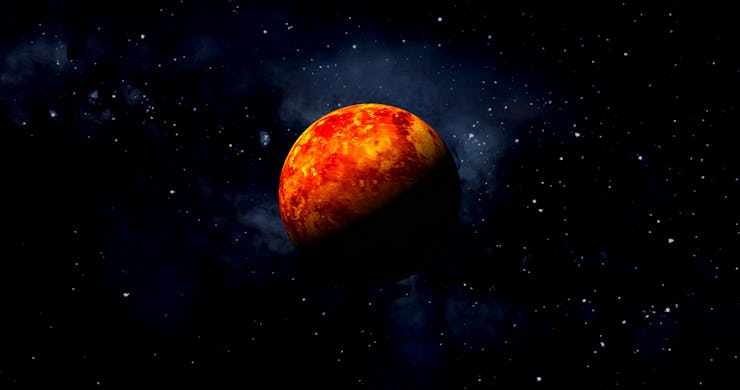New Study Shows Venus Likely Didn't Have Ancient Oceans for Long
This could rethink our view of the world as once-habitable.

If there’s one thing that’s clear about Venus, it’s that it’s inhabitable. You just need to take one look at its clouds of sulfuric acid, winds that regularly reach 240 miles per hour, crushing pressure, and surface temperatures that reach 900 degrees Fahrenheit. (If there’s one thing that’s not clear about Venus, it’s the 12-mile-thick layer of clouds that reaches up to an altitude of 42 miles, covering the surface entirely.)
But Venus is also extremely dry. Dryer than a bone: up to 100 times drier than the Atacama Desert in Chile, the driest place on Earth. What astronomers and planetary scientists don’t agree on is how long that’s been the case. But a paper published this week in the Proceedings of the National Academy of Sciences finds that, unless future missions to Venus are able to find lava that acts as an oxygen sink, Venus’ watery era ended long ago: three billion years ago, four times longer than other estimates.
To model the history of Venus’ atmosphere, the team — Alexandra Warren and Edwin Kite of the University of Chicago — needed to know when Venus theoretically had liquid water on the surface and relatively habitable environment.
How to Find an Ancient Ocean
Reconstruction of surface features of Venus.
Even after billions of years, an ocean of water would leave its mark on Venus’ atmosphere. As molecules of H2O in the upper atmosphere are struck by the Sun’s photons, the hydrogens break away and escape, leaving oxygen behind. But in addition to everything else inhospitable about Venus, its atmosphere contains very little oxygen. If Venus ever had an ocean, something must have happened to its oxygen, too.
That oxygen had three ways it might have disappeared from the atmosphere. In one case, it could have oxidized into carbon dioxide, though this is one of the less likely scenarios. Instead, most of Venus’ oxygen likely suffered one of two fates: being blasted into space by radiation, or being incorporated into magma on the surface. Venus’ post-greenhouse heat once meant that much of the surface was covered in volcanic eruptions and lava flows that never solidified.
But those eruptions billions of years ago introduced radioactive elements that can still be detected in Venus’ atmosphere today. By modeling the decay of these elements and different ways oxygen could disappear from the atmosphere, the team worked out just how much liquid water could once have flowed over Venus’ surface.
How Much Water Did Venus Have?
Venus today is a far cry from the Venus of the early Solar System.
The answer is: not much. Venus’ oxygen levels are only enough for an ocean of about 300 meters global equivalent layer (GEL), the term planetary scientists use to refer to the total amount of water on a planet if you smoothed and evened the whole surface out. Earth, for example, features of GEL of 2700 meters — that is, if you averaged out all the continents and oceans, you’d be left with a layer of water 3000 meters deep across the surface. Mars, on the other hand, has a current GEL of 20 to 30 meters —and an estimated ancient one of between 100 and 1500 meters.
If ancient Venus had much more water, they explain, it would either have more oxygen, too much carbon monoxide, or a surface that — 1.5 billion years after the modeled onset of Venus’ runaway greenhouse effect — would still be so hot as to be covered in magma. And if Venus did have an ocean, the current supply of volcanic gasses like potassium-40, which decays into argon-40, means that the incredible amount of volcanic activity required to absorb it must have happened upwards of three billion years ago.
But all this is limited by the sparse data we actually have about Venus, despite it being Earth’s closest neighbor. The last mission to survey Venus’ topography, NASA’s Magellan, ended in a fiery plunge into the thick clouds of sulfuric acid in 1994. In the intervening three decades, improvements in remote sensing have meant that researchers have much better data about the makeup of the lithospheres of Earth and Mars.
But Venus’ surface, hidden below those clouds, remains poorly constrained. Estimates of the makeup and tectonics of Venus’ crust vary widely, and that makes it difficult to model the processes that led to its current blistering-hot state.
With luck, though, that will change in the next decade. Two NASA missions, VERITAS (Venus Emissivity, Radio science, InSAR, Topography, And Spectroscopy) and DAVINCI (Deep Atmosphere Venus Investigation of Noble gases, Chemistry, and Imaging), along with the ESA probe EnVision, are expected to arrive in 2031. DAVINCI will be the first mission to duck below Venus’ clouds since the Soviet Vega probes, launched by a country that no longer exists, in 1985.
Understanding the makeup of Venus’ surface will help understand the ways — if any —that Venus’ surface was shaped by water. Even though you might expect a surface that averages a lead-melting 847 degrees Fahrenheit to be devoid of traces of water, these missions will look for ancient lavas like andesite and rhyolite that form in the presence of water.
This article was originally published on